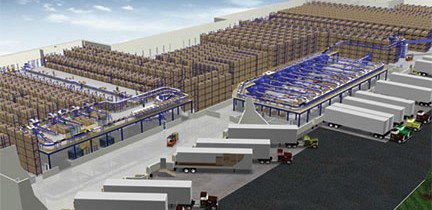Omni Channel Demands Advanced Order Fulfillment and More Efficient Distribution Center Design
New supply chain configurations and technological advances in fulfillment are influencing not only building size requirements, but also the location and build-out of the facilities, according to a report by Cushman & Wakefield.
Amazon is leading this trend, building new state-of-the-art distribution facilities to deliver on its goal of same-day deliveries in most major markets, and most of these facilities are one million square feet or greater.
In order to compete, other retailers are also occupying mega-facilities, such as Home Depot’s 1.6 million square foot facility at the CenterPoint Intermodal Center in Chicago and a 1.1 million square foot facility in Atlanta. The list of large tenants pursuing build-to-suit developments includes consumer product companies like Procter & Gamble, which built a 1.7 million square foot distribution center in the PA I-81/I-78 Distribution Corridor and a 1.4 million square foot distribution center in the Inland Empire. Beverage-maker PepsiCo has a 1.2 million square foot distribution center under construction in Dallas.
While these mega distribution centers make up a only small fraction of total new construction, overall warehouse and distribution center building size is continuing to increase. The average warehouse under construction is between 300,000 to 350,000 square feet and is greater than 500,000 square feet in several markets.
According to the report, in the PA I-81/I-78 Distribution Corridor, where the existing average warehouse is over 300,000 square feet, the average new warehouse is more than double the size nearing 900,000 square feet. In Dallas, the average warehouse currently under construction is over 550,000 square feet, compared to an 100,000 square foot average existing warehouse.
As the distribution center footprint is expanding, so is ceiling height. Clearance height in the new facilities is typically 36 to 40 feet. This height can accommodate two mezzanine levels for picking and packing.
These new square footage requirements, including horizontal and vertical space, are necessary to accommodate high-velocity picking and packing, rather than the more traditional cubic storage of products. Newly built omni channel fulfillment centers are also differentiated from traditional distribution centers by specialized features including greater building depth, with wider column spacing to accommodate a new generation of warehouse management systems. These facilities also have specialized material handling equipment and racking, and frequently a cross-dock configuration.
The 2014 MHI Annual Industry Report – Innovations That Drive Supply Chains identifies omni channel as a top strategic priority among supply chain professionals. Click here to learn more about MHI members whose solutions support omni channel and advanced order fulfillment.





